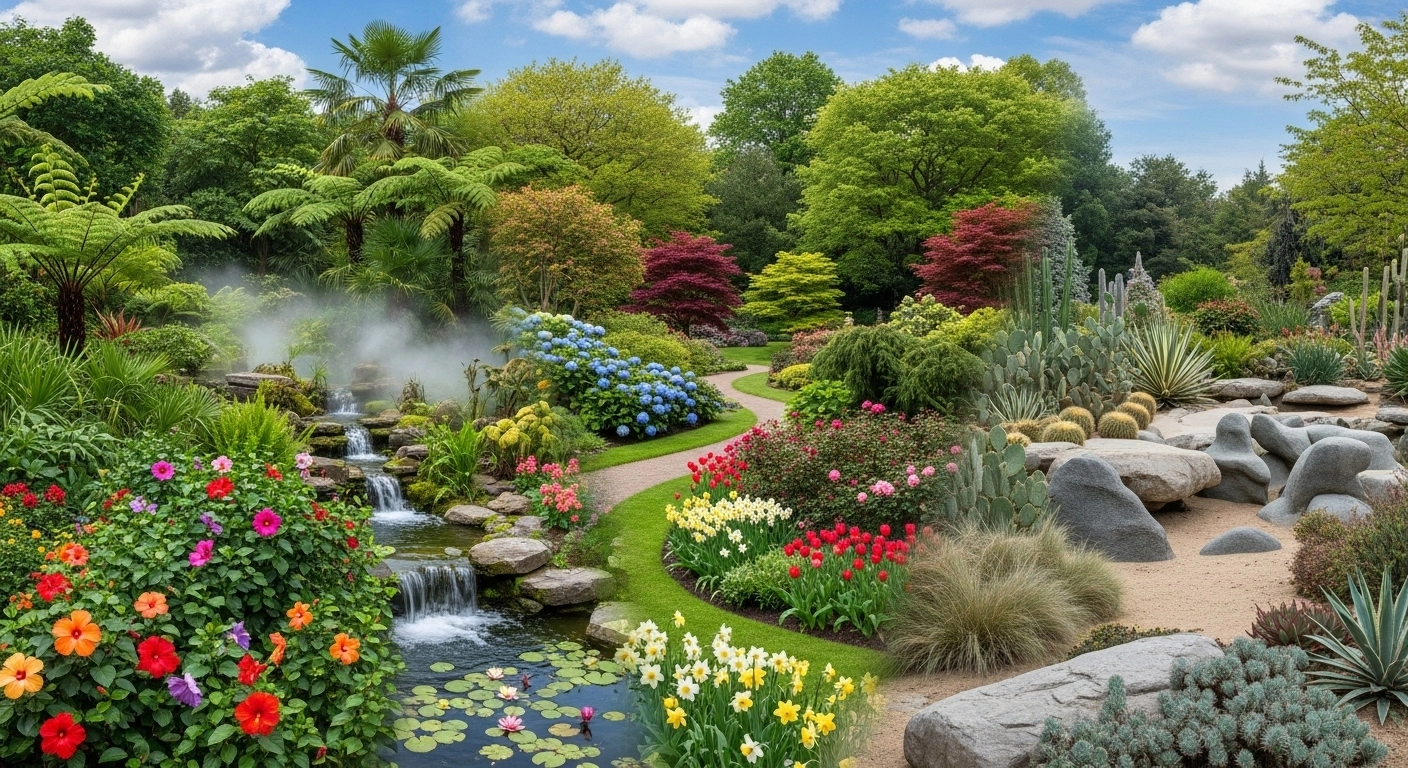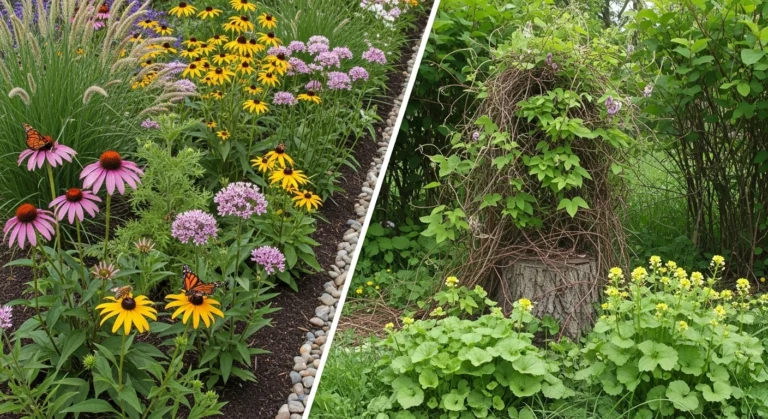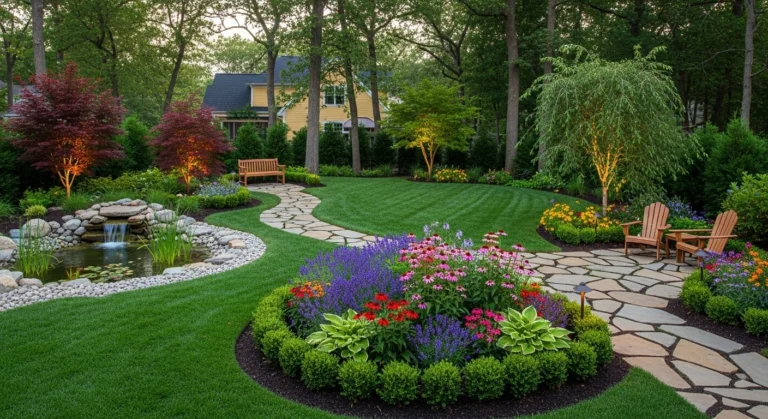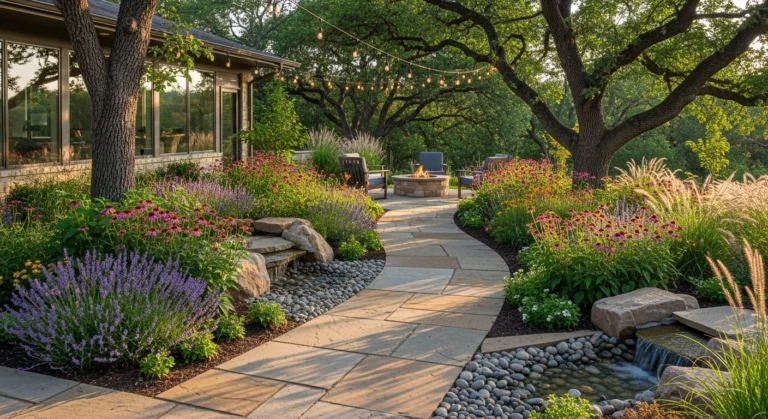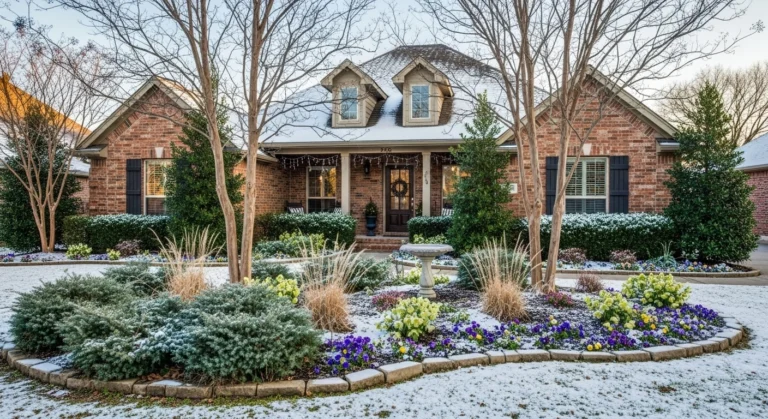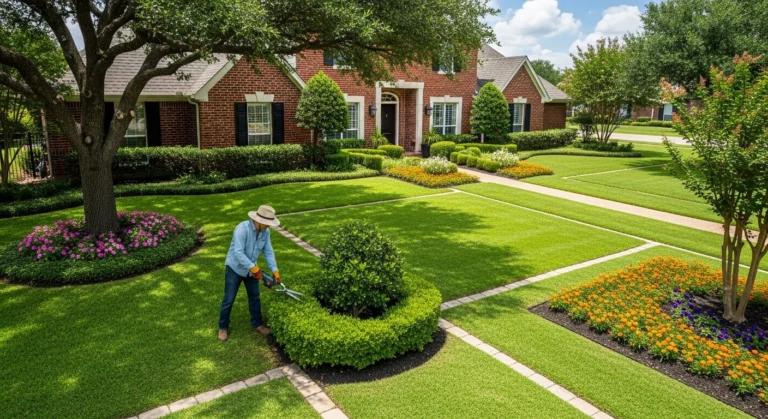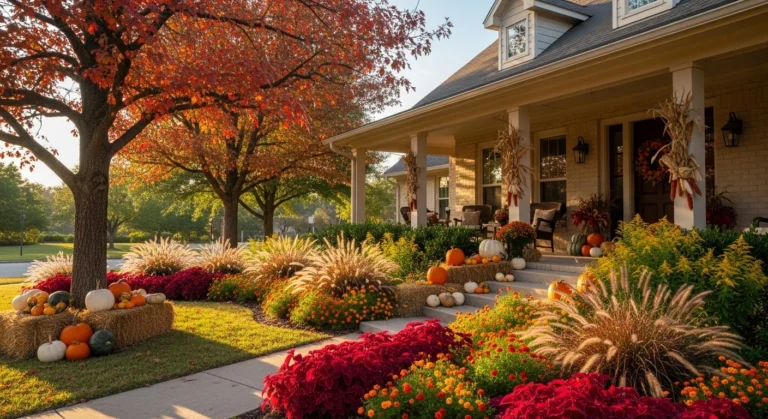Have you ever wondered why your neighbor’s garden looks like something out of a magazine while yours seems to be in a constant state of struggle, despite following the same watering schedule and fertilizer routine? You’re probably dealing with one of the most frustrating mistakes in landscaping – choosing plants that simply aren’t suited for Lubbock’s unique climate zone and soil conditions. Every spring, we watch homeowners invest hundreds or even thousands of dollars in beautiful plants from the nursery, only to see them wither, struggle, or die within a few months. It’s heartbreaking and expensive, especially when you’ve put so much hope and effort into creating your dream landscape.
The good news is that plant selection success isn’t about luck or having a “green thumb” – it’s about understanding the science behind climate compatibility and soil requirements. We’ve discovered that homeowners who match their plant choices to Lubbock’s specific growing conditions enjoy gardens that not only survive but absolutely thrive with minimal intervention. The secret lies in understanding your USDA hardiness zone, recognizing your specific soil type, and selecting plants that view our challenging conditions as their ideal home. When you get this foundation right, your plants will reward you with vigorous growth, stunning blooms, and the kind of resilience that makes gardening feel effortless instead of exhausting.
Understanding Lubbock’s Climate Zone Characteristics
Living in USDA Zone 7b, Lubbock presents some unique challenges that make generic gardening advice practically useless for our specific conditions. Our semi-arid climate means we experience dramatic temperature swings, intense summer heat, and unpredictable precipitation patterns that can stress plants not adapted to these extremes. What makes our zone particularly challenging is the combination of low humidity, high winds, and alkaline soil – conditions that many popular garden plants simply can’t handle long-term.
The average annual rainfall in Lubbock hovers around 19 inches, which is significantly less than what most traditional garden plants require to thrive without supplemental irrigation. Our growing season typically runs from mid-April through late October, but late spring freezes and early fall cold snaps can catch gardeners off guard if they’re not familiar with our weather patterns. We’ve seen beautiful landscapes devastated by unexpected weather events because the plant choices weren’t matched to our climate realities.
Microclimates within Lubbock can vary significantly from neighborhood to neighborhood, creating additional complexity for plant selection. Urban heat island effects, wind exposure differences, and varying soil drainage patterns mean that what works beautifully in one part of town might struggle just a few miles away. Understanding these local variations through our Landscaping Services becomes crucial for making smart plant choices that deliver long-term success.
Decoding Your Soil Type and Its Impact
Soil analysis is probably the most overlooked aspect of plant selection, yet it’s often the determining factor between gardening success and failure. Lubbock’s soils range from sandy loam to heavy clay, with many areas featuring caliche hardpan layers that create drainage challenges and root penetration issues. Most nursery plants are grown in ideal potting soil conditions, so they experience shock when transplanted into our native soils without proper preparation.
The pH levels in Lubbock soils typically run alkaline (7.0-8.5), which affects nutrient availability and limits the success of acid-loving plants that thrive in other regions. Alkaline soil conditions can cause iron chlorosis, nutrient lockup, and poor root development in plants not adapted to these conditions. We always recommend soil testing before major plant installations because understanding your baseline soil chemistry prevents costly plant failures and ongoing frustration.
Drainage characteristics vary dramatically across Lubbock properties, from areas with excellent natural drainage to spots that hold water for days after heavy rains. Compacted soils from construction activity or heavy foot traffic create additional challenges that affect root development and water infiltration. Smart plant selection takes these soil realities into account, choosing species that can handle your specific drainage and compaction conditions rather than fighting against them.
Plant Selection Strategies for Long-Term Success
Matching Plants to Your Specific Zone Requirements
Zone-appropriate plant selection starts with understanding that hardiness ratings represent minimum survival temperatures, not optimal growing conditions. A plant rated for Zone 7 might technically survive our winters but could struggle with our intense summer heat, low humidity, and alkaline soils. We’ve learned to look beyond basic hardiness ratings and consider the complete environmental picture when recommending plants for Lubbock landscapes.
Heat tolerance is often more critical than cold hardiness in our climate, as summer temperatures regularly exceed 100°F for extended periods. Plants that thrive in cooler climates may survive our winters but suffer significant stress during July and August, leading to poor performance and increased susceptibility to pests and diseases. Drought tolerance and wind resistance are equally important factors that many gardeners overlook when selecting plants based solely on appearance or availability.
Native plant species and adapted plants from similar climates offer the highest probability of long-term success because they’ve evolved to handle conditions like ours. These plants don’t just survive in Lubbock – they actually prefer our growing conditions to more moderate environments, resulting in healthier, more vigorous growth with significantly less maintenance input from homeowners.
Soil-Specific Plant Recommendations
Clay soil plants need species that can handle poor drainage during wet periods and extremely dry conditions during droughts. Plants like Texas Red Oak, Flame Leaf Sumac, and Buffalo Grass have developed root systems and physiological adaptations that allow them to thrive in clay soil conditions that would stress or kill plants adapted to sandy, well-draining soils.
Sandy soil gardening requires plants that can handle rapid drainage and lower nutrient retention, but these conditions also offer advantages for certain plant types. Desert plants and Mediterranean species often perform beautifully in sandy Lubbock soils, providing stunning visual impact with minimal water and maintenance requirements once established.
Alkaline soil plants include many native Texas species that have evolved with our soil chemistry and actually perform better in alkaline conditions than in neutral or acidic soils. Plants like Cenizo, Desert Willow, and various native grasses don’t just tolerate alkaline soils – they thrive in them, often displaying better color, stronger growth, and increased flower production compared to their performance in “ideal” garden soils.
Creating Successful Plant Communities
Companion planting principles work beautifully when you group plants with similar soil and climate requirements together, creating communities that support each other naturally. Water-wise plant combinations allow you to establish efficient irrigation zones that deliver appropriate moisture levels without overwatering drought-tolerant species or underwatering plants with higher moisture needs.
Layered plantings that mimic natural ecosystems create more resilient landscapes that require less ongoing intervention. Canopy trees provide shade and wind protection for understory shrubs, which in turn shelter ground-level plants from temperature extremes and moisture loss. This approach reduces individual plant stress while creating more visually interesting compositions than traditional foundation plantings.
Succession planting ensures continuous seasonal interest while working within your climate and soil limitations. Early spring bulbs adapted to your soil type give way to summer perennials that handle heat and drought, followed by fall-blooming natives and plants with attractive winter structure. This approach provides year-round appeal while respecting your specific growing conditions.
Native Plants: Your Best Investment for Climate Success
Top Native Choices for Lubbock Conditions
Texas native plants represent your best investment for creating landscapes that thrive rather than merely survive in our challenging conditions. These plants have evolved specifically to handle our soil chemistry, precipitation patterns, and temperature extremes without human intervention. Little Bluestem, Sideoats Grama, and Buffalo Grass provide excellent ground cover options that remain attractive through seasonal changes while requiring minimal water and maintenance.
Native tree species like Mesquite, Texas Red Oak, and Chinkapin Oak offer long-term landscape structure that improves with age while providing shade, wildlife habitat, and seasonal interest. These trees develop deep root systems that help them access moisture during drought periods while their canopies create beneficial microclimates for smaller plants. Native shrubs including Agarito, Fragrant Sumac, and Fourpoint Evening Primrose provide excellent foundation plantings that require minimal care once established.
Wildflower species native to our region offer spectacular seasonal color displays that rival any cultivated flower garden while requiring no supplemental watering, fertilizing, or replanting. Indian Blanket, Bluebonnet, and Purple Coneflower create stunning spring and summer displays that attract beneficial insects and birds while thriving in our native soil conditions.
Benefits Beyond Plant Survival
Native plant ecosystems provide environmental benefits that extend far beyond individual plant health and survival. These plants support native wildlife populations including beneficial insects, birds, and small mammals that contribute to overall ecosystem health and natural pest control. Deep-rooted native species help prevent soil erosion, improve water infiltration, and build soil organic matter over time.
Water conservation benefits from native plant landscapes can reduce outdoor water usage by 50-75% compared to traditional landscaping approaches, resulting in significant long-term cost savings. Reduced maintenance requirements mean fewer hours spent on watering, fertilizing, pruning, and replanting, giving you more time to enjoy your outdoor spaces rather than constantly working to maintain them.
Property value enhancement through attractive, sustainable native landscapes appeals to environmentally conscious buyers while demonstrating responsible land stewardship. Native landscapes often increase in beauty and value over time as plants mature and ecosystems develop, unlike high-maintenance landscapes that can become liabilities if not constantly maintained.
Integration with Non-Native Adapted Plants
Compatible non-native species from similar climates can complement native plant selections while expanding your design palette and extending seasonal interest periods. Mediterranean plants like Rosemary, Lavender, and Sage thrive in our alkaline soils and low-water conditions while providing culinary herbs and attractive foliage textures.
Great Plains species from regions with similar climate patterns often perform excellently in Lubbock landscapes, offering additional options for color, texture, and seasonal variety. Plants like Ornamental Grasses from Kansas and Nebraska, or Prairie Wildflowers from similar latitude regions can integrate seamlessly with native Texas species.
Careful selection criteria for non-native additions should include drought tolerance, alkaline soil compatibility, and heat resistance to ensure these plants can thrive alongside your native species. The goal is creating plant communities where all species support each other rather than competing for resources or requiring conflicting care regimens.
Soil Testing and Preparation Essentials
Understanding Your Soil Through Testing
Professional soil analysis provides crucial information about pH levels, nutrient content, organic matter percentages, and potential soil amendments needed for optimal plant performance. We recommend comprehensive soil testing every 3-5 years, as soil conditions can change over time due to irrigation practices, fertilizer applications, and organic matter decomposition. DIY soil testing kits can provide basic pH and nutrient information, but professional lab analysis offers more detailed insights into trace elements and soil structure characteristics.
Seasonal testing timing affects results accuracy, with late fall or early spring providing the most reliable baseline measurements before active growing season nutrient uptake begins. Multiple sampling locations across your property help identify variations in soil conditions that might require different plant selections or amendment strategies in various landscape areas.
Interpreting soil test results requires understanding how different measurements affect plant selection and performance rather than simply trying to achieve “ideal” numbers that might not be appropriate for your chosen plant palette. Some plants actually perform better in “poor” soils, while others require specific nutrient profiles to reach their potential.
Soil Amendment Strategies
Organic matter additions can improve both clay and sandy soils by enhancing water retention in sandy areas while improving drainage and aeration in clay soils. Compost, aged manure, and native mulch materials break down gradually, providing ongoing soil improvement benefits while supporting beneficial soil microorganisms that enhance plant health.
Drainage improvements may require mechanical solutions like French drains or raised planting beds in areas with persistent standing water or hardpan layers. However, many soil drainage issues can be addressed through strategic plant selection of species adapted to your existing drainage conditions rather than expensive soil modification projects.
pH adjustment considerations should focus on selecting plants adapted to your natural soil pH rather than attempting to dramatically alter soil chemistry, which requires ongoing maintenance and can create nutrient imbalances. Sulfur applications can gradually lower pH for acid-loving plants, while lime additions can raise pH, but these modifications work best for small, contained planting areas rather than large landscape installations.
Creating Optimal Planting Conditions
Planting hole preparation techniques can significantly improve plant establishment success without requiring wholesale soil replacement across large areas. Backfill soil amendments using native soil mixed with appropriate organic matter create transition zones that encourage root expansion while avoiding the “bathtub effect” that can occur with drastically different soil types.
Root zone considerations include understanding how different plants establish and spread their root systems in your specific soil conditions. Deep-rooted plants may require initial soil loosening to depth, while shallow-rooted species benefit more from surface soil improvements and appropriate mulching strategies.
Timing soil preparation activities with seasonal weather patterns optimizes soil workability while avoiding compaction during wet periods or excessive moisture loss during dry spells. Our Landscaping Design Guide provides detailed seasonal timing recommendations for various soil preparation activities.
Common Plant Selection Mistakes to Avoid
Impulse Buying Without Research
Nursery shopping without planning leads to collections of individual plants that may not work well together or suit your specific growing conditions. Beautiful displays at garden centers often feature plants from various climates and soil requirements grouped together for visual appeal rather than compatibility. Seasonal availability doesn’t necessarily indicate appropriateness for your climate zone, as many nurseries stock plants based on regional distribution networks rather than local growing conditions.
Online plant purchases require even more careful research, as photographs can’t convey information about mature plant size, growth habits, or environmental requirements. Impulse additions to existing landscapes often disrupt established plant communities and irrigation zones, creating ongoing maintenance challenges that defeat the purpose of thoughtful landscape design.
Trend-following in plant selection often emphasizes appearance over performance, leading to disappointment when trendy plants fail to thrive in your specific conditions. Social media and gardening magazines typically showcase plants in ideal growing conditions that may not match your climate zone and soil type realities.
Ignoring Mature Plant Characteristics
Spacing miscalculations based on nursery plant sizes rather than mature dimensions create overcrowded conditions that lead to competition, poor air circulation, and increased disease pressure. Growth habit ignorance results in plants that outgrow their intended spaces, requiring constant pruning or eventual removal and replacement. Invasive tendencies in certain plants may not be apparent during the first growing season but can create ongoing management challenges as plants establish and spread.
Maintenance requirement underestimation leads to landscapes that start manageable but become overwhelming as plants mature and their care needs increase. Seasonal appearance changes that aren’t anticipated can result in landscapes that look great for part of the year but unattractive during dormant periods or seasonal transitions.
Root system considerations affect foundation plantings, septic systems, and underground utilities, with problems often not becoming apparent until plants reach maturity. Mature height and spread information helps prevent conflicts with overhead utilities, building structures, and neighboring property lines that become expensive to resolve later.
Overlooking Local Microclimates
Sun exposure assumptions based on limited observations can lead to plant stress and poor performance as seasonal sun angles and mature canopy development change growing conditions over time. Wind exposure variations across properties significantly affect plant moisture loss and cold hardiness, with protected areas allowing less hardy plants to succeed while exposed areas require more resilient species.
Drainage pattern ignorance results in plants struggling with too much or too little moisture as seasonal rainfall patterns and mature landscape water flow patterns develop. Heat reflection from hardscape elements, buildings, and vehicles creates localized temperature extremes that affect nearby plant performance and watering requirements.
Neighboring influence from adjacent properties, including mature trees, structures, and irrigation practices, affects growing conditions in ways that may not be immediately apparent but become significant as your landscape matures. Microclimate evolution occurs as your own plantings mature and create new shade patterns, wind blocks, and moisture retention areas that change growing conditions over time.
Seasonal Planting Strategies for Success
Optimal Planting Windows
Fall planting advantages in Lubbock allow root establishment during cooler months, preparing plants for their first summer stress test with better-developed root systems. September through November typically provides ideal conditions for most perennial plants and tree installations, as soil temperatures remain warm while air temperatures moderate and occasional rainfall supports establishment.
Spring planting timing requires careful attention to last frost dates and soil temperature conditions, with March through May offering windows for different plant types. Annual flowers and vegetables should wait until soil temperatures consistently reach appropriate levels, while woody plants can often be installed earlier if properly protected from late freezes.
Summer planting challenges include extreme heat stress and increased watering requirements, but certain heat-loving species actually establish better during warm periods. Container-grown plants handle summer installation better than bare-root specimens, and native species adapted to summer heat often establish successfully with appropriate irrigation support during their first season.
Seasonal Care and Establishment
First-year plant care requires understanding that even drought-tolerant plants need consistent moisture during establishment, typically requiring 12-18 months to develop root systems capable of surviving on natural rainfall alone. Watering schedules should focus on deep, infrequent applications that encourage deep root development rather than frequent shallow watering that creates surface-dependent root systems.
Mulching strategies help moderate soil temperatures and retain moisture during establishment while suppressing weed competition that can stress newly installed plants. Organic mulches break down gradually, improving soil structure, while inorganic mulches provide permanent coverage with zero maintenance requirements.
Protection measures during extreme weather events help young plants survive conditions they’ll easily handle once mature and established. Shade cloth, wind barriers, and frost protection may be necessary during the first growing season for plants that will eventually thrive without intervention in your specific microclimate.
Long-Term Landscape Evolution
Patience with plant development allows landscapes to reach their full potential rather than rushing to fill spaces with inappropriate quick-growing species that may create problems later. Phased installation approaches spread costs over multiple seasons while allowing you to observe how initial plantings perform before adding complementary species.
Natural plant succession in well-designed landscapes creates increasingly stable and self-sustaining plant communities that require less intervention over time. Mature landscape benefits include improved soil conditions, established beneficial insect populations, and resilient plant communities that can weather extreme conditions with minimal human intervention.
Adaptive management strategies allow for adjustments and improvements based on actual plant performance in your specific conditions rather than rigid adherence to initial design plans. Successful landscapes evolve over time through thoughtful observation and strategic modifications that enhance overall performance and beauty while maintaining compatibility with your climate zone and soil conditions, as detailed in our comprehensive Landscape Maintenance resources.
Ready to choose plants that will thrive in your specific growing conditions? Contact Lawn Care Lubbock today to discuss your plant selection needs and learn how we can help you create a landscape perfectly matched to your climate zone and soil type.

